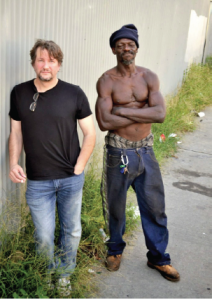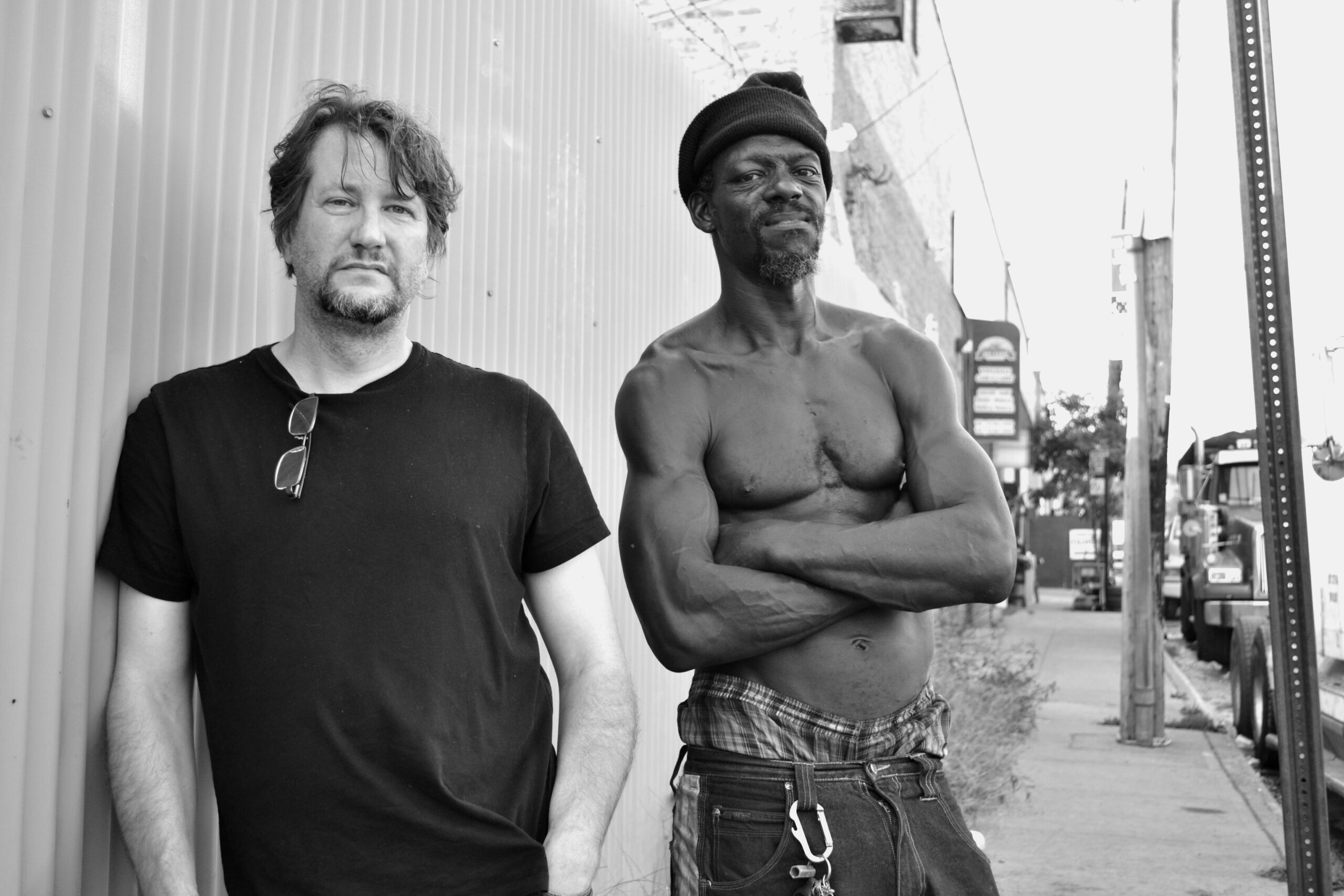Photographer Profiles and Bonds with Addicts.
After a 30 minute drive north of downtown Manhattan, past the commuter-swarmed bridges and highways, you will find yourself in a world of high unemployment and neglect. In a desperate attempt at urban art or to attract business, car brake lights are tied to chain-link fences, above buildings devoid of company logos and residents. Packs of young boys dribble basketballs down the street with no visible destination. Street food vendors idle, surveying the streets, without customers. At times, cars surge pass and for a brief moment Hunts Point is bustling. Most times the streets are desolate, aside from a stray cat or strung out junkie.
On the pedestrian bridge above a busy Hunts Point expressway, Chris Arnade gives drug addict and prostitute Sarah some change for “white people cigarettes” (Marlboros). She rounds the corner to score some heroin and Arnade alternates between watching her belongings and surveying the bleak industrial backdrop. When she returns a few minutes later, they wait for cars to pass and enter a doorway. Amidst the Amtrak train tracks and traffic, this shooting gallery is home for Sarah and several other addicts. It reeks of vile bodily fluids and self-neglect. “Granted you’re homeless and you’re living under a bridge, but it’s still your home, treat it like one,” fellow addict and ex-resident Michael comments in abhorrence after Arnade mentions the smell.
For the past two years, ex-Wall Street banker Chris Arnade, 48, has habitually traveled between his spacious “cat and kid infested” Brooklyn Heights apartment and Hunts Point — where half the population lives below the poverty line, while crime, prostitution and the local drug trade flourish. With the help of Cassie Rodenberg, writer and public school teacher in the South Bronx, Arnade photographs and documents the life of addicts in this troubled neighborhood, many whom he counts as friends.
“I say ‘friends’, although I’m sitting here in my Brooklyn Heights apartment while they sleep under bridges up there [Hunt’s Point],” said Arnade in an interview with the Free Press. “We use each other. I use them for photos, and they use me. Sometimes for $10 or a ride, and to tell their story.”

The images are a stark insight into the life of addicts, pimps, prostitutes and drug dealers. Regular people surviving the only way they know how, according to Arnade, who has met many who have lived the lifestyle since teenagers. “Everyone in Hunts Point is doing drugs, dealing drugs or running away from drugs,” he says before he trails off, distracted by notifications on his computer. On both his home computer and iPad, Arnade impulsively checks his email, Facebook, Twitter, Tumblr and Flickr accounts. At times, Arnade stops mid-sentence and inspects his sites again for comments and online conversations.
Arnade uses a straightforward and blunt approach when photographing his subjects — possible remnants from his hectic Wall Street days. Yet he easily communicates with strangers, especially those in hard situations. Arnade is genuine, but never emotional in his relationships with subjects. He is not afraid to take a shot if the photo will tell an affective story.
Arnade has never been an addict himself, nor lost any family members due to addiction. His interest in the addict’s world is murky. “I’m still trying to figure my life out,” he said.
Although Arnade says his projects are an ongoing curiosity, he has found the political message behind his work. “We can’t try to fix poor neighborhoods. We need to fix all of us, our culture that allows this [poor neighborhoods] to happen,” he said.
After quitting CitiGroup in June 2012, Arnade has yet to work another job. While still working on Wall Street, Arnade began exploring peripheral New York neighborhoods and subcultures, after his mind had “checked out” from his daily routine. What began as an exploration progressed into a commitment. Most days Arnade found himself walking 20 miles to places like East New York, Brooklyn and Far Rockaway, Queens, photographing faces, graffiti and pigeon keepers.
Although he made enough in his previous career to support himself and his family, Arnade says the money is not enough to call this an early retirement. “It’s going to be hard doing anything else,” he said. “At some point I’ll have to make money for my family.”
*****
In August 2011, Arnade arrived in Hunts Point for the first time, visiting a Catholic Monastery with his mother. He kept returning in spite of constant warnings from friends and family of the neighborhood’s danger. “This is a really depressing neighborhood,” Arnade said. “It’s a gated community in the wrong way.”
The first person Arnade shot in Hunts Point was an addict named Supreme and addict and prostitute Takeesha. Like most people he profiles, Arnade tried to remain in touch with the two, but has since lost contact. “I just received three phone calls [from other subjects he visits] this morning,” said Arnade while fingering his phone, barefoot at his home office desk, splitting and swallowing sunflower seeds into a nearby bowl.
The subjects Arnade photographs inhabit a world often ignored, where people are ostracized and don’t know how to get help or get out. “I don’t try to question their story. I don’t do journalism. I write their story as they tell it to me,” Arnade says.

Photo by Chris Arnade
For every photo he takes, Arnade asks his subjects to “describe themselves in one sentence,” something he says is not usually awarded homeless people in the media because of their brute honesty.
“I am more than just a naked prostitute who smokes crack. I may seem comfortable being that but I am not,” said subject Carmela from Arnade’s online photo project Faces of Addiction.
*****
Emotive topics like homelessness and drug addiction are not popular subjects within the book publishing industry. “When you publish work about addiction, you get attacked all the time,” said Canadian photographer and fan of Arnade’s work, Tony Fouhse. In 2007, Fouhse undertook a three-year photo project entitled User, capturing Canada’s drug users.
Last year, after Fouhse invited Arnade to speak at the School of the Photographic Arts where Fouhse teaches in Ottawa, Canada, he came to New York and took a more in-depth look at Arnade’s work. “He’s doing what he’s doing without any art history baggage,” which Fouhse said was refreshing in photography. “But I told him ‘you’re in the midst of it and you don’t know what you’re doing.’” Fouhse believes Arnade can tell a bigger story with his photographs but he has yet to find it.
Fouhse’s photos of addicts aren’t nearly as graphic as Arnade’s. Fouhse’s works are predetermined collaborations between him and his subjects, while Arnade’s photographs look deeply in the neglected homes and lives of addicts. Most are candidly shooting up and using, or sick and looking their worst, with emptiness and tears in their eyes.
Arnade has yet to publish his work outside of his own blog and social media accounts. “In the U.S., publishers want a book that’s a guaranteed sale,” he says. Since 2011, Arnade has sent four submissions to different publishers for book ideas and has never heard a response. Arnade says he wants to publish a book of stories, less focused on the photos and more focused on the writing.
While Arnade’s work is not in demand in the publishing world, online viewers and fellow New Yorkers have taken interest in his photos. New York Times reporter Corey Kilgannon learned of Arnade in late 2011 after profiling Barbara Terry, longtime Hunts Point prostitute. Arnade met and photographed Terry the night before Kilgannon approached her. Two months later, Kilgannon profiled Arnade.
Kilgannon was interested in Arnade’s story because Arnade was working on Wall Street at the time, during the height of Occupy Wall Street’s beginning. “You don’t see much of it [profiling addicts and prostitutes], people think it’s too gritty or unsavory,” Kilgannon said. “It takes guts, especially for someone who doesn’t need the money.”
Arnade enjoys helping out his subjects. At times he assists them with money or food, but he also runs potential risks like police raids while in addicts’ homes. “If I die tomorrow, I’ll be happy with what I’ve done,” he explains. “I don’t want to be 60 with a lot of money just traveling the world hoping not to die.”
In the future, Arnade plans to travel again to Juarez, Mexico, to document and explore the open-ended serial female homicides in the Mexican City, depicted in the book 2666, by Chilean novelist Roberto Bolaño. “I like to go where people tell me not to,” Arnade said with a smirk.








Hello, this weekend is good in favor of me, as this moment i am reading this enormous educational post here at my house.
Heya i’m for the first time here. I found this board and I find It truly useful &
it helped me out much. I hope to give something back and aid others
like you aided me.
Peculiar article, just what I needed.
Hey there are using WordPress for your blog platform?
I’m new to the blog world but I’m trying to get started and create my
own. Do you require any html coding knowledge to make your own blog?
Any help would be really appreciated!
The awareness of a community called “Hunts Point” or “Hunters Point” in SF is usually on the south side, an industrial area, military based that no one wants to cultivate any more. Who does that? the city administration, the government? or the people that live there? People want to stay away from those communities due to the negativity of the environment. So how do you change the conditions, give a solution, There has to be more to it then lipsyncking. Is anyone really rolling up their sleeves and getting to work to make these communities change back to once flourishing areas. More resources, more jobs, more churches to open their doors and not just on Sundays. If you live there you have to help make it change.
“Everyone in Hunts Point is doing drugs, dealing drugs or running away from drugs,” he says before he trails off, distracted by notifications on his computer. Clearly Arnade is getting his information from the web and not the community. Where are the folks that are running away? Not been my experience as a former resident and who currently visits the community on a regular basis. Frankly, the reporter also should do some work and get out into the community and talk to folks who live and work there. If we were to subscribe to Arnade’s point of view, we are either junkies, prostitutes or incapacitated victims.